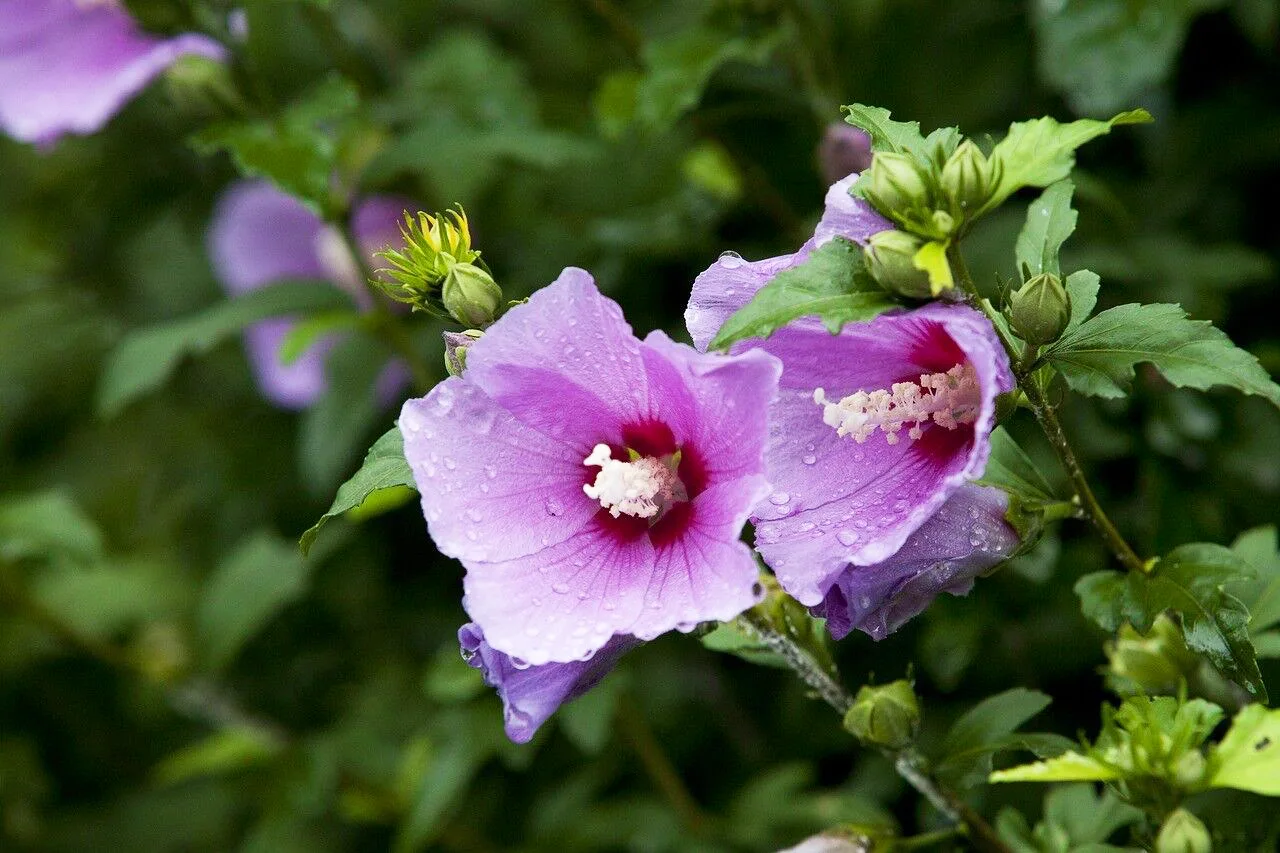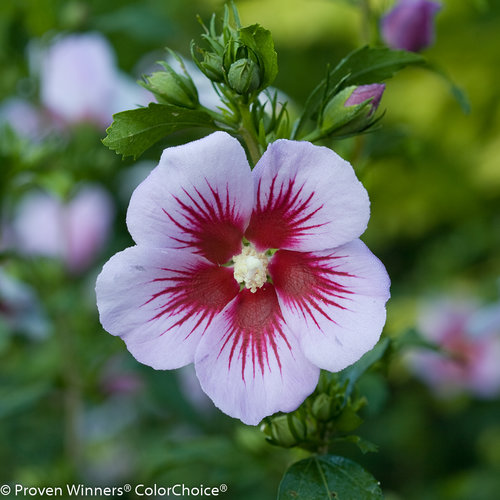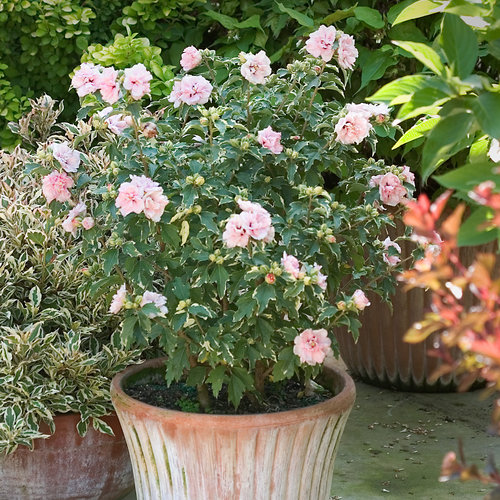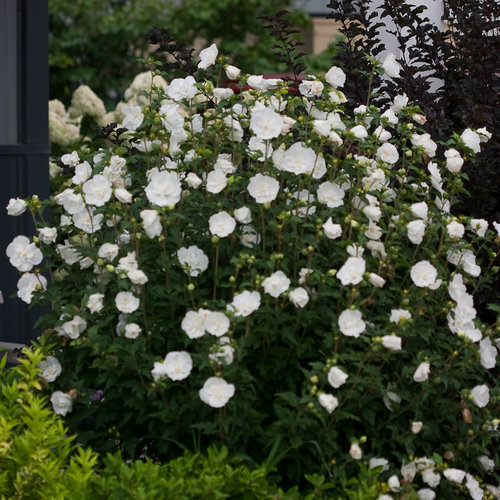
Written by s • Rose of Sharon – Some New Takes on an Old Favorite
There was a time when the arrival of a new plant was a great event. When that happened in Europe around 1600, when a new, remarkable bush began to appear in gardens, one with very large flowers like nothing ever seen before, it certainly was seen as a near-miracle. But what was this remarkable new flower? They knew it had arrived with traders from the Middle East, the fabled lands of the Bible. Looking inside for guidance, people discovered this passage in the ‘Song of Songs’ (2:1), where a woman tells her lover:
“I am the rose of Sharon, a rose of the valley”
Surely this new and beautiful blossom must be that fabled ‘rose of the valley’? It was certainly beautiful enough! So it soon became known as Rose of Sharon. It had come from Syria, which at that time was larger than today, and included all the Holy Lands. It was under the control of the Ottoman Empire, and the end of the Silk Road, the ancient caravan route that connected China with the Ottomans, and through them with Europe. Why is that important? Because we know now that Rose of Sharon was not from the Middle East at all, but native to China and Korea, where it had been grown in gardens for centuries.
A Well-travelled Plant
Even the great Linnaeus, creator of the naming system we use for plants, got it wrong. He called this plant Hibiscus syriacus – the Syrian Mallow – because its true origin was still not known in his time, the 18th century. It is still not known for sure, but surely seeds of this plant had travelled alongside tea and precious silks, along the staging posts of the Silk Road, before finding, in the Middle East, a climate where it thrived.
It thrived there because this is a plant that loves heat and sun. The Rose of Sharon takes her time, growing through spring and summer before opening her first blossom, but then keeping going for weeks and weeks. It does this best where summers are long, hot and sunny, which is why it has been so popular for so long in Texas and drier southern states. It was once a staple plant of every garden, but last century it fell out of favor, not fitting so well with the garden tastes of the time, and perhaps displaced by the arrival of tea roses, which bloom not only in early summer, but again in early fall, when Rose of Sharon is also in flower.
If We Could Just Get Rid of Those Seeds. . .
There were other reasons too for its decline. Like so many plants, once seeds begin to develop, flowering slows and stops. So removing the finished flowers quickly – ‘deadheading’ – is necessary to keep blooms coming, and with flowers that last just a few days, deadheading a 12-foot shrub is rarely practical! A prolific seed producer, this raises a second problem. In warmer parts of the country those seeds are scattered around, and then sprout, creating weed issues in your garden, and sometimes escaping further afield. Although not a serious threat, plants have been reported growing wild in several eastern states, from Kentucky and Tennessee to Virginia.
The solution was to grow varieties that didn’t create seeds – sterile forms, and the first successes with that came from one of our most famous plant breeders, Dr Donald Egolf, who worked at the US National Arboretum in D.C. Famous for crape myrtles and lilacs, in the 1960s he created several beautiful sterile varieties of the Rose of Sharon, all named after Greek goddesses (‘Diana’, ‘Minerva’, and ‘Helene’, are among the most popular and enduring today). Not only as these varieties never weedy or invasive, they never stop flowering, and it often takes a hard frost to stop them blooming.
New Takes on an Old Favorite
That was 50 years ago, so perhaps it’s time for something new? So here are some newer, exciting Rose of Sharon varieties – all sterile, non-weedy and never needing dead-heading to keep them blooming from mid-summer to frost.
The lush petals of the blooms of the Rose of Sharon have a soft, smooth feel, so the name SATIN® is certainly appropriate for a colorful group of seedless varieties. In a range of colors – my special favorites are ORCHID SATIN® and PURPLE SATIN® – these compact varieties are medium-sized to large shrubs, reaching 12 feet in ideal conditions if untrimmed, but easily controlled to half that.

You will love the beauty of these great plants, all completely sterile, so no tedious dead-heading – the blossoms just drop discretely to the ground. As lawn shrubs or in the background, they are trouble-free winners, and of course if you want a casual but neat screen for summer privacy, they make great hedges too. Both have the classic single flowers, like trumpets, and if you choose the lovely pink-lilac blooms of ORCHID SATIN® or the rich purple of PURPLE SATIN®, you will also be captivated by the lovely dark-red star that fills the center of these blooms. Released by Proven Winners®, they are both the work of professional plant breeders.
That certainly isn’t true of another great newer Rose of Sharon – SUGAR TIP®.

New varieties often come by chance, and it was chance that gave gardener Sharon Gerlt, who lives in Independence, Missouri, the opportunity to invent her own new plant. She was growing an old variety called ‘Lady Stanley’, and spotted a unique branch that not only had very different flowers that were double soft-pink, but also had variegated foliage with creamy-white edges on all the leaves. Growing a variegated Rose of Sharon like this means great garden color for those early weeks before blooming begins, and that’s a huge bonus. Like many variegated plants, SUGAR TIP® is more compact, easily kept to 6 feet tall, and it has excellent dense branching – it’s a real winner.
Finally, no garden is complete without white – the universal color that never clashes and always brightens, bringing class and style to the simplest planting. For a white Rose of Sharon, look no further than the amazing WHITE CHIFFON®, another plant with a different back-story.

Meet Roderick Woods, whose bushy beard is worn as proudly as his accomplishments. A child who loved plants, he was ‘diverted’ into more than 30 years as a teacher and researcher in physiology in Cambridge, England, before returning to his first love when he retired. It was his life-long enthusiasm for Rose of Sharon that led to his CHIFFON® series, and we especially love the purity of WHITE CHIFFON®. The huge flat flowers are 4 inches across, startling white, which a charming double center that means no seeds are produced. You will love it, out in the garden or in a large planter – simply gorgeous.
Check out our Hibiscus page for these, and other great varieties of what is the very best of all the late blooming shrubs – Rose of Sharon.





